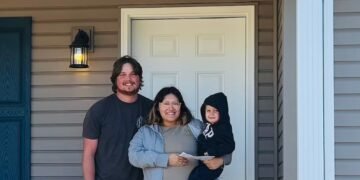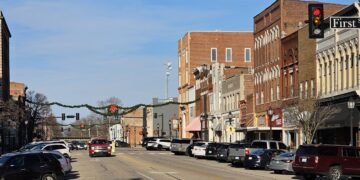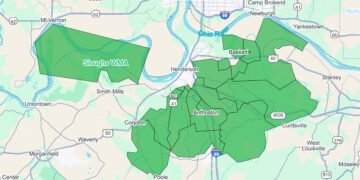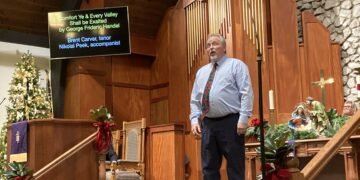The Henderson City Commission Wednesday evening approved the request for an amendment of a zoning in the Braxton Park subdivision that will allow some residences of a planned development to be built on smaller lot sizes.
After a tense, nearly two-hour hearing, two commissioners, Rodney Thomas and Austin Vowels, as well as Mayor Brad Staton voted to approve the Henderson-Henderson County Joint Planning Commission’s Dec. 5 recommendation that allows what had been 80-feet-wide lots to be decreased to 60-feet-wide lots for the development.
The hearing was held because Braxton Park residents appealed the joint planning commission’s recommendation. The city gives final approval on changes in zoning. Mayor Brad Staton initially indicated that the city commission would not hold a hearing and pass a resolution accepting the planning commission’s recommendation. But the mayor and city commission decided at the Feb. 20 city commission meeting to hold the hearing.
H Properties LLC, headed by John Hodge, plans to build the homes in the back part of the subdivision. Chris Hopgood, who represents Hodge, argued that the medium density residential zoning of the development didn’t change, only the size of some lots, which is allowable according to zoning regulations.
Hopgood also said that only 11 of the 34 planned homes would be built on the reduced lot sizes, and he said Hodge has pledged to not build any homes less than 1,400 square feet.
But Brian Bishop, a resident of Culpepper Court in the neighborhood, contended that the language of the city’s approved zoning ordinances and subdivision regulations should prohibit smaller lot sizes in the medium density residential zoning. He said the lot sizes will be smaller than what is allowable in city regulations for that zoning.
Bishop is also the executive director of the joint planning commission and had recused himself from any of the staff preparations before the Dec. 5 planning commission meeting and stepped out of that meeting when this amendment was being deliberated and voted on. He first spoke publicly against the planning commission’s recommendation at a February city commission meeting.
Bishop’s argument hinged on language in the definition of “building site” in the zoning section of the city’s ordinances, which says that a building site must be developed “with the requirements of the subdivision regulations [Appendix A of this Code] and this ordinance, whichever is more restrictive.”
Bishop emphasized the phrasing “whichever is more restrictive” often throughout the meeting because he said the subdivision regulations are more restrictive in this case, establishing that lot sizes in medium density residential zoning be between 10,000 and 40,000 square feet. He said the city cannot allow the 60-feet wide lots because the total size of those are about 7,800 square feet.
“It’s in black and white,” he said. “You cannot approve this.”
City Codes Administrator Steve Davis, though, said that according to the zoning regulations, a medium density residential zoning allows for a 7,000-square-foot lot for single family residences (not a duplex or other multi-family unit).
Bishop rebutted that, saying that “the more restrictive use” must be followed, therefore lots smaller than 10,000 feet could not be approved.
Later, City Attorney Dawn Kelsey asked for a short recess to review the ordinance and subdivision regulations. Once the hearing reconvened, Staton called Davis back up to the podium. He repeated that the regulations say that the minimum lot size for the medium density zoning for a single-family residence is 7,000 square feet. He added that the regulations say that the minimum width of a lot is 60 feet for the same zoning. Kelsey agreed.
But Bishop went to the podium once more, again emphasizing the language he’d mentioned throughout the meeting.
“If you do this, you have just guaranteed a loss in court,” he said.
In the end, Staton had one final question for Kelsey: “Is it your opinion that if we approve this matter that we will be in violation of our written standards or ordinances that we have in place?”
“It is my opinion that you will not be in violation,” Kelsey responded.
At its December meeting, the joint planning commission recommended to approve the amendment with a 7-2 tally. Additionally, David Dixon, the chair of the joint planning commission—who only votes to break ties—said Wednesday he would have voted to approve.
Vowels motioned to approve the recommendation. Thomas seconded. The vote was 3-0. (City commissioners Nick Whitt and Robert Pruit were not present.)
After the meeting, Bishop said he and neighbors are concerned that the size of the proposed houses—at least 1,400 square feet—will decrease their property values. He said similar homes in the Henderson community are valued at $200,000 while current residences in the Braxton Park subdivision average $325,000.
When asked if he thought there were any conflicts of interest in his testimony, Bishop said he was “well within my rights as a citizen” to speak regardless of his employment. He said he didn’t know yet if he or other neighbors would pursue action in circuit court.
Hopgood told the Hendersonian he believed it was “human nature” for homeowners to be leery of new development in their neighborhood. But, he said, “If nothing ever goes in your backyard, how are we ever going to develop?”
With the Wednesday guarantee of houses being no smaller than 1,400 square feet, Hodge has changed his development plans three times in response to neighborhood complaints. He said he was glad Wednesday’s vote went his way. He said dirt work could begin this summer if there are no other holdups.
(This article was updated Sunday, March 24, with additional background information)



















